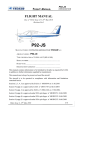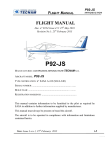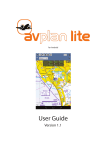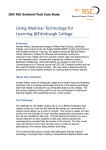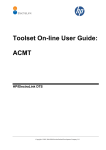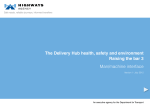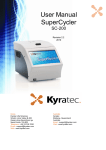Download Products Register User Guide - LU
Transcript
Products Register User Guide 1 Products Register - User Guide Contents General: 03 Products Register: Purpose 04 Scope 05 Outline of roles, workflow and records Guidance: 06: Description of key roles 07: User access and enquiries 08: How to find a product 09: Propose a new product 10: LU sponsor support 11: Confirmation that requirements are satisfied (support; conditionally support or refer back): 12: Product Approval (support; conditional support; withdraw or refer back) 13: Withdrawal of an authorised product 14: Special Case: Testing & Trial Sites 15: Process overview 16: Frequently asked questions (FAQs) LU APR User Guide. Ver 1.03, May2010 2 Products Register Purpose The purpose of the products register is to: • provide an accessible catalogue of products which are accepted as suitable for purpose in relation to the LU network • provide consistent approvals workflow and records • promote innovation and shared learning across LU and suppliers • reduce / eliminate duplication of assurance approvals • obtain consent to test / trial products insitu • support LU Standard 1-011 Registration of Products LU APR User Guide. Ver 1.03, May2010 3 Return to contents page Scope The Approved Products Register is applicable to: • • • London Underground and its suppliers Any asset group Any Product type, including ... Physical products: Other products: • Items, parts / components • Drawings • Assemblies of parts • Requirements / specifications • Proprietary materials & products • Processes • Custom made materials & products • User / operation manuals • Plant & equipment approvals LU APR User Guide. Ver 1.03, May2010 4 Return to contents page Workflow & Records LU APR User Guide. Ver 1.03, May2010 5 Return to contents page Roles & Responsibilities Role Description General User A person with read-only access permission to the products register. General Users can search for and view products that are at any stage in the workflow and print product certificates and public supporting documents / evidence. Proposer A person who is associated with a specific organisation and has proposer permissions can propose new products for registration and instigate the approvals workflow. The Proposer of a product cannot also be its Sponsor or Approver. A proposer should work with Sponsor and other interested parties to build the case for acceptance (establish the requirements to be met and demonstrate that they are met) . Sponsor An LU Manager, or their nominated representative, who is familiar with the subject matter concerned and is able to confirm that the product has a genuine application on the London Underground network and that the case has been well developed to a state that is appropriate to submit into the acceptance stages of the workflow. Requirement Approver A person, agreed by the Product Approver, who has the appropriate competence to verify that one or more requirement(s) is/are satisfied prior to approval of the product. Acceptance Manager An LUL responsible manager or their accredited representative who has the competence and authority for overall acceptance that a product is suitable for purpose. Where requirements are set, the Product Approver also agrees the appropriateness of these and manages their approval. SQE Standards Manager Responsible for the registration process and certain stages during the product approvals workflow, including managing user access, assigning proposals to the appropriate LU Responsible Manager for Product Approval and authorising products for use. LU APR User Guide. Ver 1.03, May2010 6 Return to contents page User Access and Enquiries Request Logon New users can request access to the register online at : http://www.lu-apr.co.uk Logon Go to the web site http://www.lu-apr.co.uk and logon. Note: You will be prompted to change your password the first time you logon and following any password re-set. Enquires Please see the frequently asked questions (FAQs) at the end of this user guide. If your question has not been answered there contact the LU Standards team by email with LU-APR in the subject line: [email protected] LU APR User Guide. Ver 1.03, May2010 7 Return to contents page Find a Product Who? Any user. How? – – – – – Logon and select Search from the left hand menu. Enter the words or numbers to be searched for in the text box (space separated) or a single asterisk (*) as a wild card. Select ‘And’ to find products with all of the words or “OR” to find products with any of the words. If required you can limit the search results further by selecting from the restrict to Asset Group; Workflow Status or Manufacturer drop down options or Limit to Test Sites Click on the ‘Search’ button and then select the product you require from the search results or refine the search criteria. Tips: The search is by whole words and is not case sensitive. Words with the same root are automatically included, for example “paints” will also locate products with the words Paint, paint, painted and painting. As with most search engines be brief as fewer well chosen search words will increase the likelihood of finding a product first time. You can export the search results to Excel as a selected list of products. Note: The system’s search index does not include all of the text in Requirements and Conditions. Suitable search keywords, separated by a space, should be included by proposers in the additional information field. LU APR User Guide. Ver 1.03, May2010 8 Return to contents page Propose a product Who? Any user who has been granted Proposer permissions. How? – – – – – – – Logon and select New Proposal from the left hand menu. Complete the form presented to you and select Create to register the draft proposal, generate the unique product reference number and to save the details. You will receive an email with a link for easy access back to your proposal. With the Product open, select edit to add or amend details and save as often as required. You may log out and continue at a later date. Select your LU Sponsor from the drop down options. Consult interested parties – they can also logon to view the proposal to facilitate consultation. Add as appropriate the requirement to be met, conditions and the supporting documents / evidence. Ensure that the case demonstrates that any specific requirements are met. When ready, submit the product into the approvals workflow Tips: Contact SQE Standards if you require guidance to choose an LU Sponsor. If your chosen Sponsor does not appear in the drop down list ask them to register as a user with Sponsor permissions. The target period from submission of a proposal to decision is 4 weeks, variations to this should be agreed by the parties involved and recorded in the event log. LU APR User Guide. Ver 1.03, May2010 9 Return to contents page Sponsor a proposal Who? A user, usually an LU Employee, who has been granted Sponsor permissions. How? – – – – Log on (if not already logged on) Select My Workload from the left hand menu. Select the product from those listed in your workload You may Support, Refer Back or Reject the proposal Tips: Work with the Proposer and other stakeholdrs to ensure that the proposal is valid and demonstrates suitability for purpose. Support the proposal if you are clear that the product is appropriate for defined applications on the Underground Network. Refer back if you require significant changes to the proposal. Reject if the product is not likely to be suitable for purpose or have no known application on the London Underground Network. While logged on you may also process any other products listed in your workload. LU APR User Guide. Ver 1.03, May2010 10 Return to contents page Confirmation that requirements are satisfied Who? Acceptance Manager. Requirements Approver(s). How? Acceptance Manager: – In response to an email notification or for products in your ‘My Workload’ with a outstanding requirement count of 1 or more, select the product, check the suitability of each requirement and trigger its approval workflow. This will cause a notification to the relevant Requirement Approver(s) . Requirement Approver: – Logon, select the product from those listed in your ‘My Workload’ list and select a requirement assigned to you. – Add any conditions essential for safe application, decide the request and record the reason for acceptance or referral back. Tips: For test sites one requirement should provide consent to test (with test site details/ restrictions specified) and another relate to the to test outcome. See also Special Case – Test & Trial Sites. Support a requirement if you are clear that it has been demonstrated as satisfied in the proposal submission. While logged on you may also process any other products listed in your workload . LU APR User Guide. Ver 1.03, May2010 11 Return to contents page Product Approval Who? Acceptance Manager. How? – – In response to an email notification or for products in your ‘My Workload’ with a outstanding requirement count of zero, select the product and record your decision to move the item on through the workflow. If approval is granted, this will cause a notification to the SQE Standards Team for them to confirm due process and to authorise the product for use. Tips: Note: Products should complete the decision process within 4 weeks of submission by the Proposer unless agreed otherwise by the parties involved (Proposer, Sponsor, Requirements Approvers and the Acceptance Manager). There may be good reason for the parties to agree a shorter approval period (for straightforward cases and where there is agreement the process can be achieved in minutes / hours rather than days). Similarly a longer period may be agreed, for example if testing or trialling is required. When a shorter or longer decision period is agreed, this should be recorded by the Proposer in the event log. While logged on you may also process any other products listed in your workload. LU APR User Guide. Ver 1.03, May2010 12 Return to contents page Product Withdrawal Who? SQE Standards Manager. How? – – – Locate the item using the search tool. Withdraw the item and your record reasons for this in the event log. Ensure that relevant stakeholders, including the proposer and manufacturer are informed of the withdrawal. Tips: Products may be withdrawn for a number of reasons, usually on request from the Product Approver. Reasons can include: • Product is no longer manufactured or has become obsolete and is no longer present in the LUL network • In response to a safety alert, improvement notice, prohibition notice, an audit or investigation finding • On request from the Product Approver to withdraw it for other reasons which must be stated and recorded Note: The event log will record the date and reason for withdrawal and any subsequent re-authorisation for use. LU APR User Guide. Ver 1.03, May2010 13 Return to contents page Special Case: Testing & Trial Sites What? Testing of products in a controlled manner, including insitu testing under service conditions on the operational railway, to demonstrate suitability for purpose prior to fuller approval. Who? Proposer; Manufacturer(s); Acceptance Manager; Requirements Approvers; LU Managers, operational and maintenance staff as appropriate to the case. How? • Select “Is undergoing trial” on the Product Description tab. • Add two requirements to the proposal, each with the ‘Test Sites’ option selected. • The first of these requirements is to be used to define the test plan including nature, extent, location and timing of the test site(s) and access arrangements. Approval of this requirement provides consent to test. • The second of these requirements concerns the outcome of the test . Approval confirms that the product has satisfied the testing requirements demonstrating this aspect as being suitable for purpose. Requirements approval can be conditional and further requirement(s) could be added to control any re-testing subsequent to recommended modifications. Tips: Add evidence files to each of the test related requirements e.g. a test plan to the first requirement and the test report with recommendations to the second. The test period may vary from hours to 12 months or longer, as appropriate to the case. LU APR User Guide. Ver 1.03, May2010 14 Return to contents page Process - Overview LU APR User Guide. Ver 1.03, May2010 15 Return to contents page Frequently Asked Questions Question Explanation A manufacturer is developing modified versions of existing products. Should entirely new entries be made for these modified products or should they be temporarily 'unauthorised' to allow for new information to be added and then re-authorised? If modifying product details would remove information that needs to be retained under information policies or to use, maintain or decommission an installed products then a new entry should be created. Otherwise updating an existing entry, perhaps by updating details or adding new product versions, would be sensible with the changes described in the event log and subject to re-approval. How can the register be used to seek approval for products which are built up from a number of components, each of which need individual approval, to form an approved ‘system’ or ‘assembly’? There are essentially two approaches: 1. Process each component/element separately as products in their own right and also propose a separate product to bring the component parts together. 2. Include the component elements as separate ‘Requirements’ in a single ‘system / assembly’ product proposal. Each component can be assigned to the appropriate competent person for acceptance. Note: the whole item can only be approved by the Acceptance Manager when all of the requirements are approved. A combination of 1 & 2 can also be used. Which is the better approach? Should individual components have a use or potential use outside of the particular assembly or system then the first approach could be preferable. Should the components all be unique to an assembly then approach 2 might be better. LU APR User Guide. Ver 1.03, May2010 16 Return to contents page tfl.gov.uk 17

















